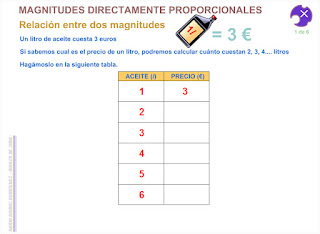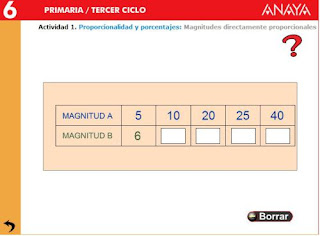Subject: Mathematics
Course / Level :1ºESO
INTRODUCTION
La unidad propone el estudio de las relaciones de proporcionalidad y los porcentajes, contenidos que ocupan una buena parte de las matemáticas de utilidad práctica en la actividad cotidiana.
La gran variedad de problemas que estos contenidos nos permiten resolver, dada la presenccia permanente de los porcentajes en la sociedad y en los medios de comunicación, hacen del aprendizaje de estos conceptos y procedimientos uno de los objetivos importantes a lograr en este curso.
1.-Learning
outcomes
1. To identify the relations of
proportionality between magnitudes.
2. To construct and interpret
tables of values corresponding to proportional pairs of magnitudes.
3. To know and apply specific
techniques to resolve problems of proportionality.
4. To understand the concept of
percentage and calculate direct percentages.
5. To resolve problems of
percentages./
2.- Subject Content
RELATIONS BETWEEN MAGNTITUDES
• Identification and
differentiation of directly and inversely proportional magnitudes.
• The relation of direct
proportionality.
– Tables of directly and
inversely proportional values.
– Equivalent fractions in
tables of directly proportional values.
– Application of the properties
of equivalent fractions to complete pairs of values in tables of direct
proportionality.
PROBLEMS OF DIRECT
PROPORTIONALITY
• Reduction to the unit method.
• Rule of three.
PERCENTAGES
• The percentage as a fraction.
• Relation between percentages
and decimal numbers.
• The percentage as a
proportion.
CALCULATION OF PERCENTAGES
• Mechanisation of the
calculation. Different methods.
• Rapid calculation of simple
percentages.
3. -Language Content / Communication
3.1-Vocabulary
Nouns: Proportion, percentage,
magnitude, constant of variation, constant ratio, accurate, compatible
number, submit
Verbs: Identify, calculate,
recognise,cuct, interpretonstr, simplify, submit
Adjectives: big, small,round, square,
Prepositions: between, into, until, upward, throughout...
Adverbs: how many, how much, never, always
3.2-Structures
It depends on
Comparatives
Such as,...such thing as..
How many, How much
Got it
1 part out of 100
3.3-Discourse type
Write the answer in simplest
form
Relation between percentages
and decimal numbers.
Which is the most accurate way
to estimate 75% of 17%?
Part=percentage of whole
Keep it up!
3.4-Language skills
Reading, listening and speaking
4.-Key competences:
Linguistic competence: - Conocer, adquirir, ampliar y aplicar el vocabulario del tema -
Ejercitar una lectura comprensiva de textos relacionados con el núcleo
temático.
Mathematical competence: -Reconocer la
necesidad de la proporcionalidad para resolver problemas de la vida cotidiana
-
Conocer el cálculo con porcentajes, que es
imprescindible para movernos con soltura en la sociedad comercial y de los
medios
-Resolver problemas
matemáticos
Autonomy and personal initiative
-Ser autónomos para realizar
las actividades individuales
Learnig to learn by their own mistakes
5.-Timing
8 sesiones: 1 introducción y
familiarización con el lenguaje. comenzamos un glosario adecuado al tema.
3 Explicación de los contenidos
y realización de ejercicios. 2 trabajo colabarativo y exposición de
conclusiones. 1Realización de test
1 revisión de resultados y
lectura de noticias
6.-Methodology
Iniciar la unidad con un video
relacionado con la proporcionalidad tras lo cual los alumnos verbalizarán
situaciones, de su propia experiencia, en las que aperecen proporcionalidades
y porcentajes. Conocimientos previos.
Exposición de los contenidos de la unidad con ayuda de la presentación prezi elaborada para este tema.
Simultáneamente se trabajará el
vocabulario en inglés relacionado con el tema y se harán ejercicios con un
grado de dificultad ascendente y de diversa formulación.Interactivos muchos
de ellos. Andamiaje
Los estudiantes confrontarán
sus soluciones con las de sus compañeros trabajando en pequeño grupo ( 8
grupos de 4 alumnos cada uno) discutiendo las diferencias, detectando errores
y llegando a acuerdos. Trabajo colaborativo
Se hará una lectura de
actualidad donde se use el término proporcionalidad.Proyecto: investigar en
pequeño grupo una aplicación de porcentajes y exponerla al gran grupo en 5
minutos.
Se hará un examen escrito para
ayudar a valorar lo aprendido.
También se tendrá en cuenta la actitud y el trabajo diario.
6.1 Observaciones
Se recomendarán actividades de
refuerzo y ampliación según se avance en el tema sirviendo la entrega de los
mismos a recuperar el tema o mejorar nota
7.-Resoursces
El glosario se hará con ayuda
de un diccionario matemático:
El video de inicio:
Presentación de los contenidos de la unidad
La web de los ejercicios
interactivos:
educaplay
Ejercicios
de refuerzo
Apoyo en español para que no se escape ningún concepto
Y para comprobar lo aprendido:
8.-Evaluation criteria and instruments
1.1. To recognise whether there
is a relation of proportionality between two magnitudes, differentiating
direct and inverse proportionality.
2.1. To complete tables of
directly proportional values and obtain pairs of equivalent fractions from
them.
2.2. To obtain the unknown term
in a pair of equivalent fractions, from the other three known ones.
3.1. To resolve problems of
direct proportionality using the reduction to the unit method and the rule of
three.
4.1. To identify each
percentage with a fraction.
4.2. To calculate the indicated
percentage of a given quantity.
5.1. To resolve problems of
direct percentages.
Intruments: to be able to know if the targets proposed have been reached, we will be able to verify them, through data analysis skills, by means of the development of a written test of the given contents and the observation of the evolution of the pupils.
ACTIVITIES ABOUT PROBABILITY
1ª SESIÓN
Comenzaremos la actividad con un VIDEO introductorio muy entretenido e interesante para el nivel de 1º ESO:
Para la adecuada comprensión del tema, trabajaremos con un glosario de
las palabras en inglés más útiles. Éste se irá completando a lo largo de
la unidad.
Usa el enlace anterior para ir elaborando nuestro glosario en tu cuaderno.
Por ejemplo:
Proportion, percentage, magnitude, constant of variation, constant ratio,
accurate, compatible number, submit
Tras debatir en inglés (cuando sea posible) lo conocido y lo desconocido estaremos preparados para:
2ª SESIÓN
Para comenzar las explicaciones nos ayudaremos de la siguiente presentación PREZI que he elaborado a tal efecto.
Proponemos a continuación una serie de ejercicios para asimilar los contenidos:
1. This table shows how the length of Keenan's essay depends on the number of hours he spends writing this week.
| Total pages Keenan has written | ||
Hours spent writing, x
| 3 | 4 |
Total pages written, y
| 3 | 4 |
How many pages does Keenan write per hour?
3ª SESIÓN
2. This graph shows how the amount of time that a receptionist named Tony spends on the phone is related to the number of phone calls he routes to employees.
What is the constant of variation?
Write your answer as a decimal or integer.
minutes per phone call
3. Shontal bought 2 postcards during 2 days of holiday. Then, on another
trip, she bought 10 postcards during 10 days of holiday. How many
postcards does Shontal buy during one day of holiday?
postcards
4. This equation shows how the total number of quizzes Mia has ever taken
in college depends on the number of weeks she has attended school this
quarter.
q = 6w
The variable w represents the number of weeks she has attended school this quarter, and the variable q represents the total number of quizzes she has ever taken in college. After attending 2 weeks of school this quarter, how many quizzes will Mia have taken in total?
quizze
5. What is 60% of 45?
6. Megan's Tea Shop has caffeinated tea and decaffeinated tea. During the
lunchtime rush, the tea shop served 84 teas in all, 25% of which were
caffeinated. How many caffeinated teas did the tea shop serve
caffeinated tea
7. €3 is what percent of €10?
Write your answer using a percent sign (%). For example, 0.5%, 12.7%, or 56%.
Write your answer using a percent sign (%). For example, 0.5%, 12.7%, or 56%.
8. The sports shop has 22 part-time employees and 66 full-time employees.
What percentage of the employees at the sports shop work part-time?
Write your answer using a percent sign (%).
4ª SESIÓN
4ª SESIÓN
Actividades como estas encontraremos en la siguiente página:
Como refuerzo y para que ningún contenido quede sin entender muchos más ejercicios interactivos:
5ª y 6ª SESIÓN
Por grupos (8 grupos de 4 alumnos cada uno) trabajarán con problemas que encontrarán en las siguientes páginas y discutirán diferencias, detectarán errores y llegarán a acuerdos.
TRABAJO COLABORATIVO.
Trabajamos con educaplay:
Y una muy interesante de porcentajes
Hay mucho más en la siguiente página:
libros vivos
7ª SESIÓN
PRUEBA para evaluar Para terminar comprueba lo que has aprendido con el siguiente OpenMark quiz.
8ª SESIÓN
Exposición de 5 minutos ante el grupo completo de una lectura buscada en internet relacionada con el tema o de una aplicación interesante de porcentajes.
Revisión de lo aprendido
This Didactic Unit is in Google Drive









No hay comentarios:
Publicar un comentario